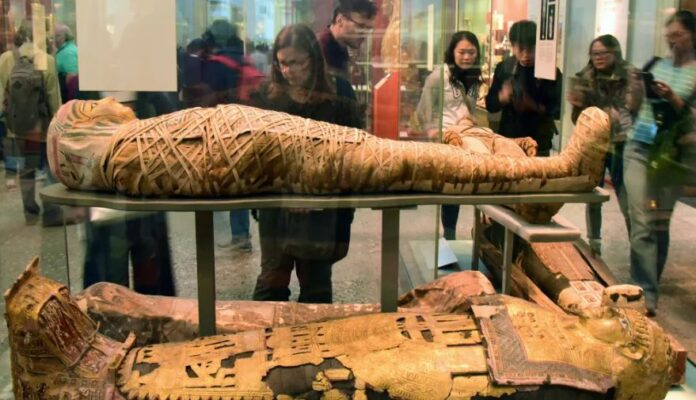London: In a revelation that defies the typical narrative of horror and decay associated with mummies, recent research from University College London (UCL) and the University of Ljubljana has unearthed a surprisingly pleasant scent from ancient Egyptian mummies.
Cecilia Bembibre, director of research at UCL’s Institute for Sustainable Heritage and co-author of the study, commented, “In films and books, terrible things happen to those who smell mummified bodies. We were surprised at the pleasantness of them.” The study, published in the Journal of the American Chemical Society, detailed the olfactory experience of analyzing nine mummies, some dating back 5,000 years, from the Egyptian Museum in Cairo.
Also Read: Elon Musk: First Mars City Could Be a Reality Within 20-30 Years
Rather than the expected stench of decay, the scent profiles were described as “woody,” “spicy,” and “sweet,” with some detecting floral notes possibly from pine and juniper resins used in the embalming process. This sensory evaluation was paired with chemical analysis to understand the origins of these scents, whether from the mummies themselves or from conservation materials like pesticides.
Matija Strlič, a chemistry professor involved in the study from the University of Ljubljana, noted, “We were quite worried that we might find notes or hints of decaying bodies, which wasn’t the case. We were specifically worried that there might be indications of microbial degradation, but that was not the case, which means that the environment in this museum is actually quite good in terms of preservation.”
The methodology involved using technical instruments to measure volatile compounds without physically sampling the mummies, a technique Strlič likened to finding the “Holy Grail” for non-invasive archaeological study. This approach not only helps in understanding the preservation state but also offers insights into the social class of the mummified individuals based on the materials used in their mummification.
Barbara Huber, a postdoctoral researcher at the Max Planck Institute of Geoanthropology, who was not involved in the study, praised the findings for providing essential data on preservation and degradation processes. She emphasized the importance of such studies for the future conservation of these ancient remains. This research not only shifts our perception of mummification’s sensory impact but also underscores the importance of non-invasive methods in preserving our understanding of ancient cultures for future generations.
Key Points:
Unexpected Aromas: A study from University College London and the University of Ljubljana found that ancient Egyptian mummies emit pleasant smells described as “woody,” “spicy,” and “sweet” rather than the expected odors of decay.
Study Details: The research involved analyzing nine mummies from the Egyptian Museum in Cairo, using both chemical analysis and human sniffers to evaluate the scents. The mummies range in age up to 5,000 years.
Scent Origins: The pleasant smells could be due to the resins like pine and juniper used in the embalming process, rather than from degradation or conservation chemicals.
Preservation Insights: The findings suggest that the museum’s environment is conducive to good preservation, as there were no signs of microbial degradation.
Non-Invasive Techniques: Researchers used advanced technology to measure air molecules around the mummies without touching them, offering a new method for studying preservation without damaging artifacts.
Cultural and Historical Value: The study provides insights into the social class of the mummified individuals based on the materials used, enhancing archaeological and curatorial understanding.
Implications for Conservation: The data could be instrumental in developing better conservation strategies for mummified remains, ensuring their preservation for future study and display.



